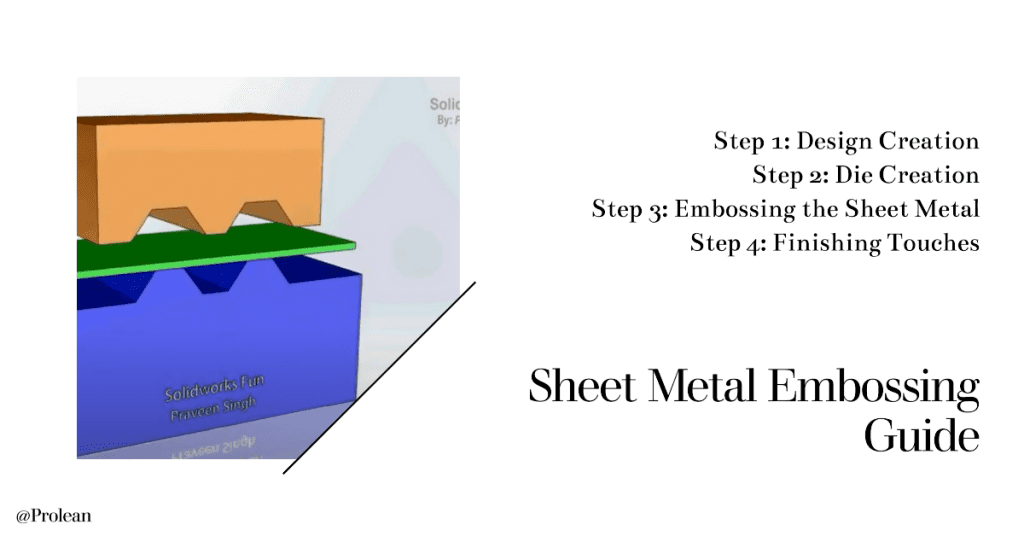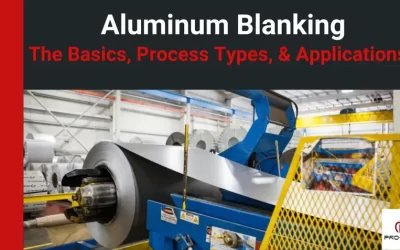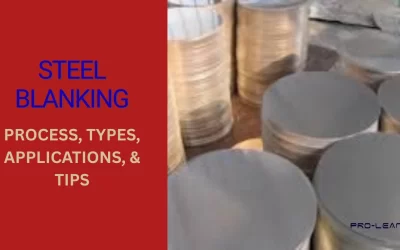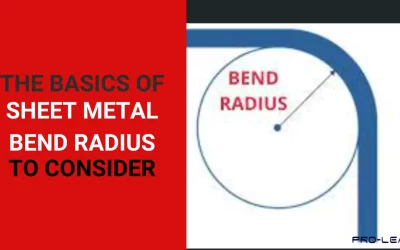
Embossing is an art form that has long been appreciated for the dimension and texture it brings to metalwork. In the context of sheet metal fabrication, embossing is a technique used to create raised or sunken designs or reliefs in metal. The process is versatile, catering to a wide range of industries from automobile and construction to arts and crafts. With a balance of pressure, heat, and precision, sheet metal can be transformed into a detailed masterpiece.
In this guide, we’ll take you through the entire sheet metal embossing process step-by-step.
Related: The Art and Science of the Sheet Metal Embossing Process
Step 1: Design Creation
Before embossing can occur, a design must be formulated. This design will be used as a blueprint for the embossing process. The design process can vary greatly depending on the complexity of the project, the precision required, and the tools available. Here is a more detailed breakdown:
| Step Number | Step | Description |
|---|---|---|
| 1.1 | Gather Your Materials | For this method, you’ll need paper, pencil, and an eraser. If you want to get more intricate with your design, a drafting compass, ruler, and protractor can come in handy. |
| 1.2 | Sketch Your Design | Begin by sketching your design onto the paper. It’s best to start simple, especially if you’re new to embossing. Remember, the design will be reversed when embossed, so any text should be drawn in mirror image. |
| 1.3 | Refine Your Design | Once you’re happy with your basic design, refine the details. If you’re using text, make sure all letters are clear and legible. |
| 1.4 | Choose Your Software | For this method, you’ll need CAD software. Options include AutoCAD, SolidWorks, or free alternatives like SketchUp or Blender. |
| 1.5 | Create Your Design | Using your chosen software, create a digital representation of your design. This is where the precision of CAD really shines – you can specify exact dimensions and angles, ensuring your design is perfect. |
| 1.6 | Finalize Your Design | Once you’re happy with your design, you’ll need to export it in a format that your die-making machinery can interpret. This is usually a CAD file or a CNC program. |
Once you’re happy with your design, you’ll need to export it in a format that your die-making machinery can interpret. This is usually a CAD file or a CNC program.
Step 2: Die Creation
Once the design is finalized, the next step in the embossing process is to create the die. The die is a hardened tool that is used to emboss the design into the sheet metal. The die-making process requires a high level of precision and expertise.
Manual Die Creation
In some cases, the die might be manually crafted. This is typically done by carving the design into a hard material, such as steel or brass. The die is then hardened to withstand the pressure applied during the embossing process.
| Step Number | Step | Description |
|---|---|---|
| 2.1 | Choose Your Material | For manual die creation, you’ll need a block of hard material like steel or brass. The size will depend on the dimensions of your design. |
| 2.2 | Transfer Your Design | If you’re creating the die manually, you’ll need to transfer your design onto the die material. This can be done by tracing, stencil, or using a transfer medium. |
| 2.3 | Carve Your Die | Using carving tools, you’ll need to remove material from your die to create your design. This can be a slow, meticulous process, and requires a steady hand. |
Machine-aided Die Creation
For larger-scale or industrial embossing projects, dies are typically created using computer numerical control (CNC) machines. These machines use CAD designs to precisely carve the design into the die material. This allows for a high degree of precision and is particularly useful for intricate designs.
| Step Number | Step | Description |
|---|---|---|
| 2.4 | Prepare Your Machine | Make sure your CNC machine is in working order, properly calibrated, and ready to carve your die. |
| 2.5 | Input Your Design | Load your design file into the machine’s software. The machine will use this file to carve your die. |
| 2.6 | Carve Your Die | Start the CNC machine. It will carve your design into the die material, creating a precise and detailed die ready for embossing. |
Step 3: Embossing the Sheet Metal
With the die now prepared, we can now move to the actual process of embossing the sheet metal. Here are the sub-steps:
| Step Number | Step | Description |
|---|---|---|
| 3.1 | Material Selection | First, select the appropriate metal sheet for embossing. Various factors such as thickness, rigidity, malleability, and the intended application of the final product will influence this decision. |
| 3.2 | Cleaning the Metal | Clean the metal sheet to ensure it’s free from any dirt, oil, or oxide layers. This step is critical to achieve a smooth embossed finish. |
| 3.3 | Positioning the Metal | Position the metal sheet on the embossing press so that it aligns perfectly with the embossing die. |
| 3.4 | Applying Pressure | The embossing press applies pressure on the metal sheet using the embossing die. This forms the metal into the shape of the die, creating the embossed pattern. |
| 3.5 | Releasing the Pressure | Once the metal has taken the shape of the die, the pressure is released. The embossed metal sheet is then carefully removed from the embossing press. |
Step 4: Finishing Touches
After the metal sheet has been embossed, a few finishing steps are necessary to complete the process. Finishing touching mainly involves inspection & quality control and post-Embossing finishing,
| Step Number | Step | Description |
|---|---|---|
| 4.1 | Visual Inspection | First, a visual inspection is done to ensure that the embossed design has been properly formed and that there are no visible defects or deformities. |
| 4.2 | Precision Measurement | For applications where precision is key, the dimensions of the embossed features might be measured using tools such as calipers or a coordinate measuring machine (CMM) to ensure they match the intended design. |
| 4.3 | Cleaning and Polishing | Depending on the metal used and the desired final appearance, a post-embossing cleaning or polishing step might be necessary. This could involve washing, brushing, buffing, or applying a protective coating. |
| 4.4 | Packaging and Shipping | Finally, the embossed metal parts are ready to be packaged and shipped to the customer or moved to the next phase of manufacturing if they’re part of a larger assembly. |
Remember that embossing is a skilled craft, and the quality of the final product depends heavily on the quality of the dies used, the properties of the metal, and the skill of the operator.
Summing Up
Embossing is a critical process in the metal-forming industry that allows for intricate design patterns to be imprinted on metal sheets. Due to its vast range of applications across industries, it plays an integral role in our daily lives, shaping products we often take for granted. The process of embossing underscores the balance between technology and craftsmanship, reflecting the innovative spirit of the manufacturing industry.
Companies such as Prolean provide advanced sheet metal embossing services that promise refined, efficient, and versatile applications in the future. If you are considering embossing for your next project, our sheet metal embossing services offer superior quality, precision, and attention to detail. With a range of services to meet your needs, Prolean can help bring your design to life, please feel free to contact us for more details.
FAQs
Can any type of metal be used for embossing?
The type of metal used for embossing will depend on the specific requirements of the project. However, embossing is commonly performed on aluminum, copper, brass, and steel.
What industries commonly use embossed sheet metal?
The automotive, construction, aerospace, and electronics industries all commonly use embossed sheet metal. It’s also widely used in arts and crafts.
Is embossing a cost-effective process?
The cost-effectiveness of embossing depends on various factors, including the complexity of the design and the type of metal used. However, for larger production runs, it can be a very cost-effective way of adding detail to sheet metal.
How long does the embossing process take?
The duration of the embossing process will depend on factors such as the complexity of the design and the quantity of sheet metal pieces to be embossed.
What is the difference between embossing and debossing?
Embossing creates a raised design on the sheet metal surface, while debossing creates an indented design.
Can embossing be used with other sheet metal fabrication processes?
Yes, embossing is often used in conjunction with other sheet metal fabrication processes, such as bending, cutting, and forming.




nicely described the process of sheet metal embossing. We are creating embossing dies manually. Which aspects will be changed if we shift die making to CNC approach? Please reply
Liu, thanks for your words! Shifting from manual to CNC machining for creating embossing dies involves several significant changes:
1. Precision and Consistency: CNC machining offers high precision and repeatability, ensuring that every die is consistent in quality and dimensions, which is challenging to achieve manually.
2. Complexity and Detailing: CNC machines can produce more complex and intricate designs than manual methods. This allows for greater creativity and detail in embossing dies.
3. Speed and Efficiency: CNC machining is generally faster than manual methods, especially for large batches. This increases production efficiency and reduces turnaround times.
4. Material Utilization: CNC machining can optimize material utilization, reducing waste through precise cutting and efficient design layouts.
The tables on the article to describe each steps of sheet metal embossing was amazing. Nice presentation!
Thanks Emily!
The write-up on this article has proven useful to me personally. It’s a chronological description of sheet metal embossing process.
Thanks Natalie!